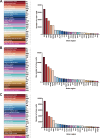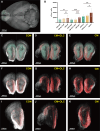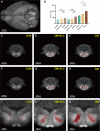Brain-wide mapping of c-Fos expression in nitroglycerin-induced models of migraine
- PMID: 39169303
- PMCID: PMC11337778
- DOI: 10.1186/s10194-024-01837-9
Brain-wide mapping of c-Fos expression in nitroglycerin-induced models of migraine
Abstract
Background: Migraine is a neurological disorder characterized by complex, widespread, and sudden attacks with an unclear pathogenesis, particularly in chronic migraine (CM). Specific brain regions, including the insula, amygdala, thalamus, and cingulate, medial prefrontal, and anterior cingulate cortex, are commonly activated by pain stimuli in patients with CM and animal models. This study employs fluorescence microscopy optical sectioning tomography (fMOST) technology and AAV-PHP.eB whole-brain expression to map activation patterns of brain regions in CM mice, thus enhancing the understanding of CM pathogenesis and suggesting potential treatment targets.
Methods: By repeatedly administering nitroglycerin (NTG) to induce migraine-like pain in mice, a chronic migraine model (CMM) was established. Olcegepant (OLC) was then used as treatment and its effects on mechanical pain hypersensitivity and brain region activation were observed. All mice underwent mechanical withdrawal threshold, light-aversive, and elevated plus maze tests. Viral injections were administered to the mice one month prior to modelling, and brain samples were collected 2 h after the final NTG/vehicle control injection for whole-brain imaging using fMOST.
Results: In the NTG-induced CMM, mechanical pain threshold decreased, photophobia, and anxiety-like behavior were observed, and OLC was found to improve these manifestations. fMOST whole-brain imaging results suggest that the isocortex-cerebral cortex plate region, including somatomotor areas (MO), somatosensory areas (SS), and main olfactory bulb (MOB), appears to be the most sensitive area of activation in CM (P < 0.05). Other brain regions such as the inferior colliculus (IC) and intermediate reticular nucleus (IRN) were also exhibited significant activation (P < 0.05). The improvement in migraine-like symptoms observed with OLC treatment may be related to its effects on these brain regions, particularly SS, MO, ansiform lobule (AN), IC, spinal nucleus of the trigeminal, caudal part (Sp5c), IRN, and parvicellular reticular nucleus (PARN) (P < 0.05).
Conclusions: fMOST whole-brain imaging reveals c-Fos + cells in numerous brain regions. OLC improves migraine-like symptoms by modulating brain activity in some brain regions. This study demonstrates the activation of the specific brain areas in NTG-induced CMM and suggests some regions as a potential treatment mechanism according to OLC.
Keywords: C-fos; Calcitonin gene-related peptide; Chronic migraine; Fluorescence micro-optical sectioning tomography; Neural circuits; Olcegepant.
© 2024. The Author(s).
Conflict of interest statement
The authors declare no competing interests.
Figures









References
-
- Jensen R, Stovner LJ (2008) Epidemiology and comorbidity of headache. Lancet Neurol 7(4):354–361. 10.1016/S1474-4422(08)70062-0 - PubMed
-
- May A, Schulte LH (2016) Chronic migraine: risk factors, mechanisms and treatment. Nat Rev Neurol 12(8):455–464. 10.1038/nrneurol.2016.93 - PubMed
-
- Al-Karagholi MA, Ghanizada H, Nielsen CAW, Hougaard A, Ashina M (2021) Opening of ATP sensitive potassium channels causes migraine attacks with aura. Brain 144(8):2322–2332. 10.1093/brain/awab136 - PubMed
MeSH terms
Substances
Grants and funding
LinkOut - more resources
Full Text Sources
Medical

